Do you have a question about the Daikin FTKM35UV16W and is the answer not in the manual?
Important safety guidelines including WARNING and CAUTION notices for user protection.
Explains the meaning of safety marks used in the manual for user awareness.
Details and labels the various parts of the indoor unit for user identification.
Details and labels the various parts of the outdoor unit for user identification.
Identifies and labels all buttons and display elements of the remote controller.
Instructions for inserting batteries, attaching accessory filters, and powering on the unit.
Procedure for turning on the main circuit breaker to power the air conditioner unit.
Explains selection and operation of cooling, drying, fan, and air purification modes.
Details on starting, stopping, and changing temperature settings for various operation modes.
Instructions on how to adjust the fan speed for optimal comfort and airflow.
Explains odor prevention and accidental operation lockout features.
How to activate and control automatic swinging of louvres for air direction.
Instructions for setting 3-D airflow and manually positioning flaps/louvres.
Details on special modes for upward airflow, rapid cooling, and energy saving.
How to set ON and OFF timers for automatic operation scheduling.
Explains the GOOD SLEEP timer for gradual temperature adjustment during sleep.
How to view inverter output, indoor temp, and set temp during operation.
How to check the current indoor temperature when the air conditioner is turned off.
How to adjust the brightness of the unit's indicator lamps and digital display.
Instructions for using the DEW CLEAN function to clean the indoor heat exchanger.
Steps for cleaning the indoor unit's exterior and removing/cleaning the front panel.
Procedure for removing, washing, and reattaching the air filters.
How to clean and maintain accessory filters, including replacement recommendations.
Guidance on replacing old accessory filters with new ones and ordering optional filters.
Steps to take before storing the air conditioner for an extended period to prevent issues.
Explains common operational sounds and minor issues that are not actual faults.
Addresses problems like unit odors, outdoor fan rotation, and remote controller malfunctions.
Covers sudden stops, blinking operation lamps, and abnormal functioning during operation.
Lists critical warning signs requiring immediate professional service and disposal requirements.
Procedure to retrieve error codes from the indoor unit using the remote controller.
Critical safety instructions for installation, including professional work and refrigerant handling.
Precautions regarding flammable gas, drain piping, and animal shelters for safe installation.
Criteria for choosing an optimal location for the indoor unit to ensure performance and longevity.
Criteria for choosing an optimal location for the outdoor unit, considering airflow and environmental factors.
Specifies the necessary clearance around the outdoor unit for proper ventilation and service access.
Details on installing the mounting plate for the indoor unit, including dimensions and screw points.
Provides specifications for pipe sizes, lengths, and additional refrigerant requirements.
Step-by-step guide for installing and removing the indoor unit, including front grille and panel handling.
Instructions on setting different addresses for multiple indoor units using remote controllers.
Detailed steps for securing the indoor unit's mounting plate to the wall.
Guidance on drilling wall holes and installing pipes for unit installation, including warnings.
Instructions for connecting refrigerant pipes and drain hoses to the indoor unit.
Specifics on connecting the drain hose and ensuring proper drainage, including embedded piping.
Detailed steps for wiring the indoor unit, including wire stripping, connection, and securing.
Instructions for connecting the drain hose and checking for smooth water flow.
Guidelines for properly wrapping insulation pipes with vinyl tape to prevent condensation and sealing.
Steps for installing the outdoor unit, flaring pipe ends, and tightening flare nuts with torque specifications.
Details on refrigerant piping, oil application, tightening torques, and insulation material selection.
Procedure for purging air from the system and checking for refrigerant gas leaks using a vacuum pump.
Instructions for wiring connections and performing drain work for the outdoor unit.
Steps for conducting trial operation to verify functionality, including checks for leaks and proper operation.
Procedure for pump down operation, essential for relocating or disposing of the unit safely.
Important safety guidelines including WARNING and CAUTION notices for user protection.
Explains the meaning of safety marks used in the manual for user awareness.
Details and labels the various parts of the indoor unit for user identification.
Details and labels the various parts of the outdoor unit for user identification.
Identifies and labels all buttons and display elements of the remote controller.
Instructions for inserting batteries, attaching accessory filters, and powering on the unit.
Procedure for turning on the main circuit breaker to power the air conditioner unit.
Explains selection and operation of cooling, drying, fan, and air purification modes.
Details on starting, stopping, and changing temperature settings for various operation modes.
Instructions on how to adjust the fan speed for optimal comfort and airflow.
Explains odor prevention and accidental operation lockout features.
How to activate and control automatic swinging of louvres for air direction.
Instructions for setting 3-D airflow and manually positioning flaps/louvres.
Details on special modes for upward airflow, rapid cooling, and energy saving.
How to set ON and OFF timers for automatic operation scheduling.
Explains the GOOD SLEEP timer for gradual temperature adjustment during sleep.
How to view inverter output, indoor temp, and set temp during operation.
How to check the current indoor temperature when the air conditioner is turned off.
How to adjust the brightness of the unit's indicator lamps and digital display.
Instructions for using the DEW CLEAN function to clean the indoor heat exchanger.
Steps for cleaning the indoor unit's exterior and removing/cleaning the front panel.
Procedure for removing, washing, and reattaching the air filters.
How to clean and maintain accessory filters, including replacement recommendations.
Guidance on replacing old accessory filters with new ones and ordering optional filters.
Steps to take before storing the air conditioner for an extended period to prevent issues.
Explains common operational sounds and minor issues that are not actual faults.
Addresses problems like unit odors, outdoor fan rotation, and remote controller malfunctions.
Covers sudden stops, blinking operation lamps, and abnormal functioning during operation.
Lists critical warning signs requiring immediate professional service and disposal requirements.
Procedure to retrieve error codes from the indoor unit using the remote controller.
Critical safety instructions for installation, including professional work and refrigerant handling.
Precautions regarding flammable gas, drain piping, and animal shelters for safe installation.
Criteria for choosing an optimal location for the indoor unit to ensure performance and longevity.
Criteria for choosing an optimal location for the outdoor unit, considering airflow and environmental factors.
Specifies the necessary clearance around the outdoor unit for proper ventilation and service access.
Details on installing the mounting plate for the indoor unit, including dimensions and screw points.
Provides specifications for pipe sizes, lengths, and additional refrigerant requirements.
Step-by-step guide for installing and removing the indoor unit, including front grille and panel handling.
Instructions on setting different addresses for multiple indoor units using remote controllers.
Detailed steps for securing the indoor unit's mounting plate to the wall.
Guidance on drilling wall holes and installing pipes for unit installation, including warnings.
Instructions for connecting refrigerant pipes and drain hoses to the indoor unit.
Specifics on connecting the drain hose and ensuring proper drainage, including embedded piping.
Detailed steps for wiring the indoor unit, including wire stripping, connection, and securing.
Instructions for connecting the drain hose and checking for smooth water flow.
Guidelines for properly wrapping insulation pipes with vinyl tape to prevent condensation and sealing.
Steps for installing the outdoor unit, flaring pipe ends, and tightening flare nuts with torque specifications.
Details on refrigerant piping, oil application, tightening torques, and insulation material selection.
Procedure for purging air from the system and checking for refrigerant gas leaks using a vacuum pump.
Instructions for wiring connections and performing drain work for the outdoor unit.
Steps for conducting trial operation to verify functionality, including checks for leaks and proper operation.
Procedure for pump down operation, essential for relocating or disposing of the unit safely.
| Brand | Daikin |
|---|---|
| Model | FTKM35UV16W |
| Category | Air Conditioner |
| Language | English |
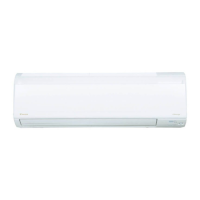
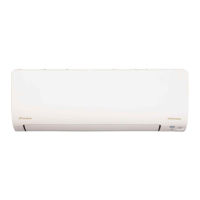




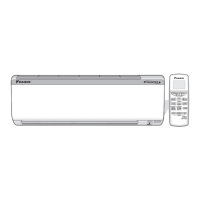
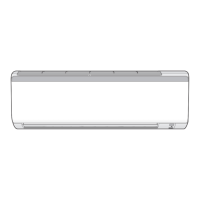



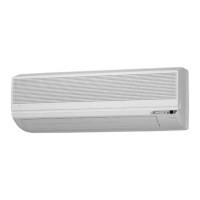
